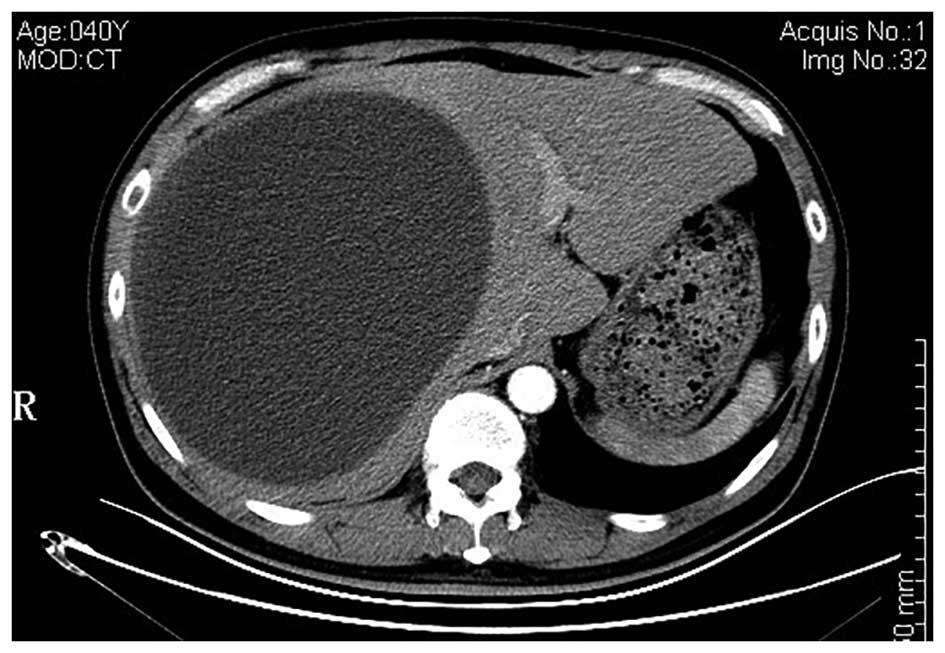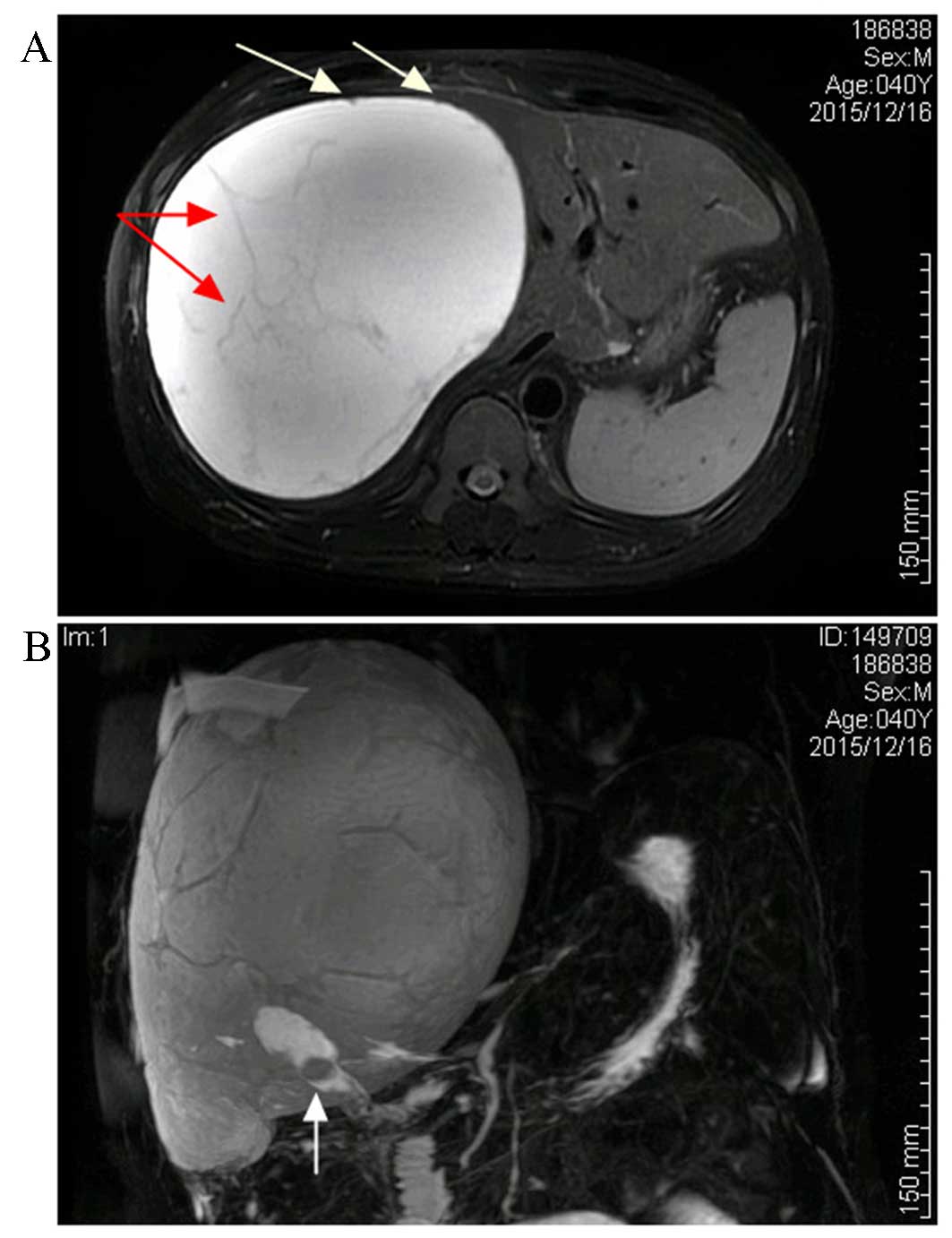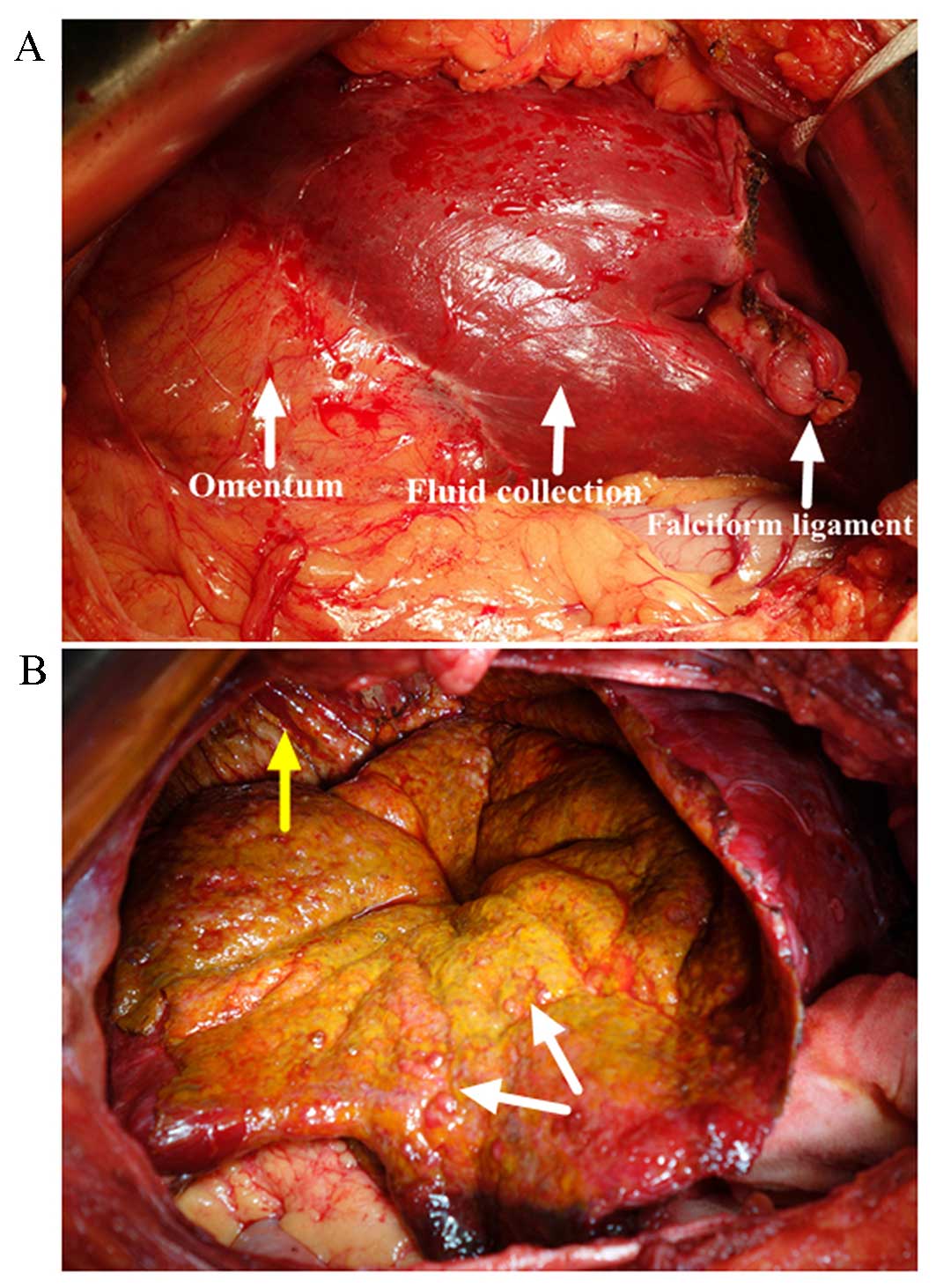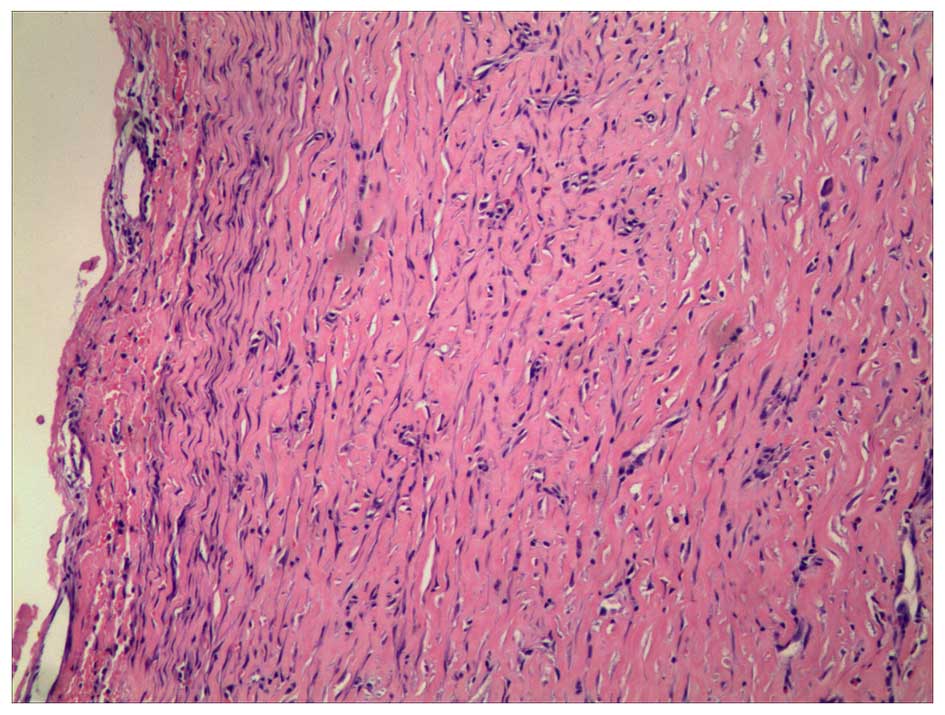|
1
|
Kannan U, Parshad R and Regmi SK: An
unusual presentation of biloma five years following
cholecystectomy: A case report. Cases J. 2:80482009.PubMed/NCBI
|
|
2
|
Göbel T, Kubitz R, Blondin D and
Häussinger D: Intrahepatic type II gall bladder perforation by a
gall stone in a CAPD patient. Eur J Med Res. 16:213–216. 2011.
View Article : Google Scholar : PubMed/NCBI
|
|
3
|
Derici H, Kara C, Bozdag AD, Nazli O,
Tansug T and Akca E: Diagnosis and treatment of gallbladder
perforation. World J Gastroenterol. 12:7832–7836. 2006. View Article : Google Scholar : PubMed/NCBI
|
|
4
|
Ausania F, Suarez S Guzman, Garcia H
Alvarez, Senra del, Rio P and Nuñez E Casal: Gallbladder
perforation: Morbidity, mortality and preoperative risk prediction.
Surg Endosc. 29:955–960. 2015. View Article : Google Scholar : PubMed/NCBI
|
|
5
|
Seyal AR, Parekh K, Gonzalez-Guindalini
FD, Nikolaidis P, Miller FH and Yaghmai V: Cross-sectional imaging
of perforated gallbladder. Abdom Imaging. 39:853–874. 2014.
View Article : Google Scholar : PubMed/NCBI
|
|
6
|
Gunasekaran G, Naik D, Gupta A, Bhandari
V, Kuppusamy M, Kumar G and Chishi NS: Gallbladder perforation: A
single center experience of 32 cases. Korean J Hepatobiliary
Pancreat Surg. 19:6–10. 2015. View Article : Google Scholar : PubMed/NCBI
|
|
7
|
Ohtake T, Kimura M, Yoshii S, Ikegaya N,
Takayanagi S, Hishida A and Kaneko E: Biloma during steroid therapy
for minimal change nephrotic syndrome. Intern Med. 32:543–546.
1993. View Article : Google Scholar : PubMed/NCBI
|
|
8
|
Niemeier OW: Acute free perforation of the
gall-bladder. Ann Surg. 99:922–924. 1934. View Article : Google Scholar : PubMed/NCBI
|
|
9
|
Date RS, Thrumurthy SG, Whiteside S, Umer
MA, Pursnani KG, Ward JB and Mughal MM: Gallbladder perforation:
Case series and systematic review. Int J Surg. 10:63–68. 2012.
View Article : Google Scholar : PubMed/NCBI
|
|
10
|
Gould L and Patel A: Ultrasound detection
of extrahepatic encapsulated bile: ‘Biloma’. AJR Am J Roentgenol.
132:1014–1015. 1979. View Article : Google Scholar : PubMed/NCBI
|
|
11
|
Kuligowska E, Schlesinger A, Miller KB,
Lee VW and Grosso D: Bilomas: A new approach to the diagnosis and
treatment. Gastrointest Radio. 8:237–243. 1983. View Article : Google Scholar
|
|
12
|
Copelan A, Bahoura L, Tardy F, Kirsch M,
Sokhandon F and Kapoor B: Etiology, diagnosis, and management of
bilomas: A current update. Tech Vasc Interv Radiol. 18:236–243.
2015. View Article : Google Scholar : PubMed/NCBI
|
|
13
|
Kalfadis S, Ioannidis O, Botsios D and
Lazaridis C: Subcapsular liver biloma due to gallbladder
perforation after acute cholecystitis. J Dig Dis. 12:412–414. 2011.
View Article : Google Scholar : PubMed/NCBI
|
|
14
|
Akhtar MA, Bandyopadhyay D, Montgomery HD
and Mahomed A: Spontaneous idiopathic subcapsular biloma. J
Hepatobiliary Pancreat Surg. 14:579–581. 2007. View Article : Google Scholar : PubMed/NCBI
|
|
15
|
Tsai MC, Chen TH, Chang MH, Chen TY and
Lin CC: Gallbladder perforation with formation of hepatic
subcapsular biloma, treated with endoscopic nasobiliary drainage.
Endoscopy. 42:(Suppl 2). E206–E207. 2010. View Article : Google Scholar : PubMed/NCBI
|
|
16
|
Ferrusquía-Acosta JA, Álvarez-Navascués C
and Rodríguez-García M: Giant biloma as a result of a blunt
abdominal trauma: A case report. Rev Esp Enferm Dig. 107:768–769.
2015. View Article : Google Scholar : PubMed/NCBI
|
|
17
|
Lee CM, Stewart L and Way LW:
Postcholecystectomy abdominal bile collections. Arch Surg.
135:538–544. 2000. View Article : Google Scholar : PubMed/NCBI
|
|
18
|
Ziessman HA: Hepatobiliary scintigraphy in
2014. J Nucl Med. 55:967–975. 2014.PubMed/NCBI
|
|
19
|
Mbarushimana S, Morris-Stiff G and Hassn
A: CT diagnosis of an iatrogenic bile duct injury. BMJ Case Rep.
2014:bcr20142049182014. View Article : Google Scholar : PubMed/NCBI
|
|
20
|
Ishii K, Matsuo K, Seki H, Yasui N, Sakata
M, Shimada A and Matsumoto H: Retroperitoneal Biloma due to
Spontaneous Perforation of the Left Hepatic Duct. Am J Case Rep.
17:264–267. 2016. View Article : Google Scholar : PubMed/NCBI
|
|
21
|
Doussot A, Gluskin J, Groot-Koerkamp B,
Allen PJ, De Matteo RP, Shia J, Kingham TP, Jarnagin WR, Gerst SR
and D'Angelica MI: The accuracy of pre-operative imaging in the
management of hepatic cysts. HPB (Oxford). 17:889–895. 2015.
View Article : Google Scholar : PubMed/NCBI
|
|
22
|
Lee CW, Tsai HI, Lin YS, Wu TH, Yu MC and
Chen MF: Intrahepatic biliary mucinous cystic neoplasms:
Clinicoradiological characteristics and surgical results. BMC
Gastroenterol. 15:672015. View Article : Google Scholar : PubMed/NCBI
|
|
23
|
Soares KC, Arnaoutakis DJ, Kamel I, Anders
R, Adams RB, Bauer TW and Pawlik TM: Cystic neoplasms of the liver:
Biliary cystadenoma and cystadenocarcinoma. J Am Coll Surg.
218:119–128. 2014. View Article : Google Scholar : PubMed/NCBI
|
|
24
|
Kakisaka T, Kamiyama T, Yokoo H, Nakanishi
K, Wakayama K, Tsuruga Y, Kamachi H, Mitsuhashi T and Taketomi A:
An intraductal papillary neoplasm of the bile duct mimicking a
hemorrhagic hepatic cyst: A case report. World J Surg Oncol.
11:1112013. View Article : Google Scholar : PubMed/NCBI
|
|
25
|
Kishida N, Shinoda M, Masugi Y, Itano O,
Fujii-Nishimura Y, Ueno A, Kitago M, Hibi T, Abe Y, Yagi H, et al:
Cystic tumor of the liver without ovarian-like stroma or bile duct
communication: Two case reports and a review of the literature.
World J Surg Oncol. 12:2292014. View Article : Google Scholar : PubMed/NCBI
|
|
26
|
Arnaoutakis DJ, Kim Y, Pulitano C,
Zaydfudim V, Squires MH, Kooby D, Groeschl R, Alexandrescu S, Bauer
TW, Bloomston M, et al: Management of biliary cystic tumors: A
multi-institutional analysis of a rare liver tumor. Ann Surg.
261:361–367. 2015. View Article : Google Scholar : PubMed/NCBI
|
|
27
|
Attasaranya S, Netinasunton N,
Jongboonyanuparp T, Sottisuporn J, Witeerungrot T, Pirathvisuth T
and Ovartlarnporn B: The Spectrum of Endoscopic Ultrasound
Intervention in Biliary Diseases: A Single Center's Experience in
31 Cases. Gastroenterol Res Pract. 2012:6807532012. View Article : Google Scholar : PubMed/NCBI
|
|
28
|
de Jong EA, Moelker A, Leertouwer T,
Spronk S, Van Dijk M and van Eijck CH: Percutaneous transhepatic
biliary drainage in patients with postsurgical bile leakage and
nondilated intrahepatic bile ducts. Dig Surg. 30:444–450. 2013.
View Article : Google Scholar : PubMed/NCBI
|













